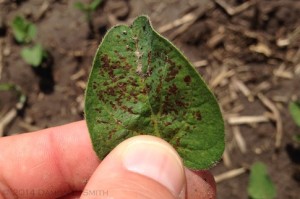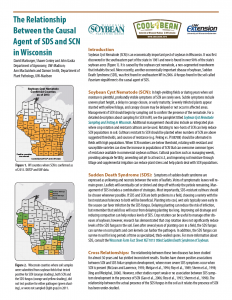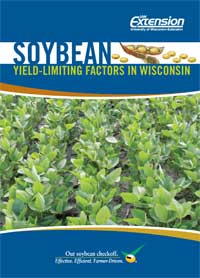Damon L. Smith – Extension Field Crops Pathologist, University of Wisconsin
Soybean planting has finally finished up for our research program. We planted our last, late planting date trial this week. Soybeans around the state have emerged and are at the VC or early V1 stage. Several diseases have been noted already this year in soybeans.

Figure 1. Septoria brown spot on a soybean seedling.
With all of the rain we have been seeing early symptoms of Septoria brown spot (Fig. 1). This is a common disease of soybean in Wisconsin and is caused by the fungus Septoria glycines. While scouting a field near Fond du Lac this week, we observed the characteristic purple-brown lesions (Fig. 2) caused by this fungus, on the unifoliate leaves of soybean plants. This isn’t unusual considering the moderate temperatures and frequent heavy rain. The spores of this fungus are typically rain splashed from old soybean debris, to the growing plants. Septoria brown spot is usually not considered a yield limiting disease, but in certain cases, it has been attributed to significant yield loss. This is usually the case where a susceptible variety is grown in a location conducive to the disease and rain is frequent and heavy. In a situation like this, fungicides might be required during the reproductive phase of growth to preserve yield. However, most of the time, Septoria brown spot is observed early in the season and again late in the season during periods of heavy rainfall and does not affect yield. I suspect, once the rain subsides a bit, this disease will also subside. However, growers and consultants should keep an eye on it just in case it does not. To learn more about Septoria brown spot, visit the brown spot information page by clicking here.

Figure 2. Purple-brown lesions characteristic of early Septoria brown spot symptoms.
Reports of seedling diseases are also starting to roll in as a result of the very wet conditions and frequent rainfall. Pythium damping off and root rot is a likely culprit in many of these fields. Cool wet soil conditions at planting and during seedling emergence favor this disease. There are many species of Pythium that can infect soybean and soybean pathologists are currently conducting a study to identify these species. An informative pocket guide has been developed. You can download a PDF version of the pocket guide by clicking here. You will note that management focuses on adjusting planting date and using seed treatments to protect against infection by Pythium species. Foliar fungicide application is NOT recommended for this disease.
Other seed and seedling diseases might also be plaguing soybeans with all of the wet weather. Other pathogens include Rhizoctonia and Phytopthora. To learn more about other seed and seedling issue of soybean in Wisconsin, click here and scroll down to “seedling diseases.” You will find helpful resources pertaining to many of the common seedling issues. Also for specific information on Phytopthora root and stem rot of soybean, you can download a UWEX fact sheet by clicking here.
Growers and consultants should scout soybeans for disease frequently during this cool wet weather. Hopefully the rain will subside soon. Some dry weather will help slow down the advancement of many soybean diseases.







